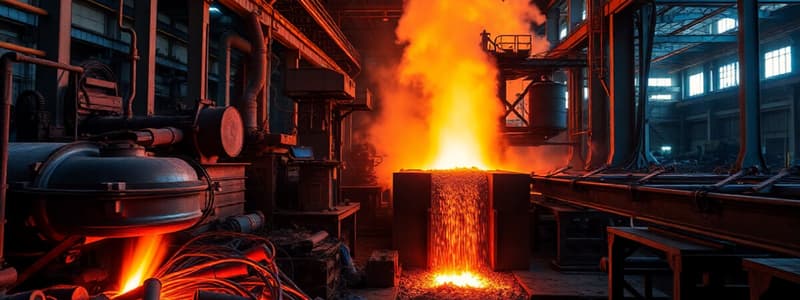Podcast
Questions and Answers
What is a significant factor affecting the comparability of production figures across nations?
What is a significant factor affecting the comparability of production figures across nations?
- Cultural influences on production
- Different political systems
- Varying resource availability
- Differing measurement methodologies (correct)
Which factor is likely to play a crucial role in future global iron and steel production growth?
Which factor is likely to play a crucial role in future global iron and steel production growth?
- Stabilizing raw material costs
- Decreasing global demand
- Emerging markets' industrial growth (correct)
- Declining raw material availability
What aspect of steel production is expected to influence future production strategies?
What aspect of steel production is expected to influence future production strategies?
- Technological limitations in production
- Market share of local producers
- Environmental impact of production processes (correct)
- Trends in consumer steel preferences
What is essential for tracking global trends in iron and steel production?
What is essential for tracking global trends in iron and steel production?
What technological advancement could potentially affect both the type and volume of steel produced?
What technological advancement could potentially affect both the type and volume of steel produced?
Which country is consistently the largest producer of both iron and steel?
Which country is consistently the largest producer of both iron and steel?
Which factor does not significantly affect global iron and steel production levels?
Which factor does not significantly affect global iron and steel production levels?
Why does the United States produce lower volumes of steel compared to China and India?
Why does the United States produce lower volumes of steel compared to China and India?
Which country is known for producing quality grades of steel but typically lower in aggregate volume?
Which country is known for producing quality grades of steel but typically lower in aggregate volume?
What role does Brazil play in global iron and steel production?
What role does Brazil play in global iron and steel production?
Which of the following is NOT a significant factor impacting production costs and efficiency in iron and steel manufacturing?
Which of the following is NOT a significant factor impacting production costs and efficiency in iron and steel manufacturing?
Which of the following countries is NOT typically ranked among the top steel producers?
Which of the following countries is NOT typically ranked among the top steel producers?
What is a primary reason for yearly fluctuations in global production levels?
What is a primary reason for yearly fluctuations in global production levels?
Which element is NOT typically considered when categorizing steel grades?
Which element is NOT typically considered when categorizing steel grades?
What is the primary focus of European standards (EN) for steel grades?
What is the primary focus of European standards (EN) for steel grades?
What aspect of steel grades would be most critical for applications requiring high formability?
What aspect of steel grades would be most critical for applications requiring high formability?
Which designation system uses a combination of letters and numbers to indicate steel composition?
Which designation system uses a combination of letters and numbers to indicate steel composition?
In steel grade selection, which factor would be least influential in a non-corrosive environment?
In steel grade selection, which factor would be least influential in a non-corrosive environment?
What is implied by the numerical sequences used in American steel standards (ASTM)?
What is implied by the numerical sequences used in American steel standards (ASTM)?
If a project requires a material that can be easily welded without losing mechanical integrity, which property should be prioritized?
If a project requires a material that can be easily welded without losing mechanical integrity, which property should be prioritized?
Which factor is likely to lead to the selection of a more expensive steel grade?
Which factor is likely to lead to the selection of a more expensive steel grade?
What aspect of steel grades primarily affects their ability to be shaped or molded into components?
What aspect of steel grades primarily affects their ability to be shaped or molded into components?
Which steel grade is characterized by excellent weldability and is commonly used for structural components?
Which steel grade is characterized by excellent weldability and is commonly used for structural components?
What is the significance of heat treatment in steel production?
What is the significance of heat treatment in steel production?
Which steel grade is known for exceptional hardness and wear resistance, suitable for high-wear applications?
Which steel grade is known for exceptional hardness and wear resistance, suitable for high-wear applications?
What factor related to steel can influence its workability during shaping and welding?
What factor related to steel can influence its workability during shaping and welding?
Which type of steel is recognized for having excellent corrosion resistance and is often used in harsh environments?
Which type of steel is recognized for having excellent corrosion resistance and is often used in harsh environments?
Which of the following factors is NOT typically important in steel designation?
Which of the following factors is NOT typically important in steel designation?
What role does standard testing play in the steel manufacturing process?
What role does standard testing play in the steel manufacturing process?
Flashcards
Global steel production comparison challenges
Global steel production comparison challenges
Different countries may use varying methods to measure iron ore and steel output, making direct comparisons unreliable.
Reliable steel production data
Reliable steel production data
Consistent yearly data collection methods are necessary for accurate global trend analysis and prediction.
Economic stability and steel production
Economic stability and steel production
Stable global economies are crucial for supporting consistent iron and steel production patterns.
Future steel production drivers
Future steel production drivers
Signup and view all the flashcards
Environmental impact on steel production
Environmental impact on steel production
Signup and view all the flashcards
Global Iron & Steel Production
Global Iron & Steel Production
Signup and view all the flashcards
Major Steel Producers
Major Steel Producers
Signup and view all the flashcards
China's Steel Production
China's Steel Production
Signup and view all the flashcards
US Steel Production
US Steel Production
Signup and view all the flashcards
Yearly Production Fluctuations
Yearly Production Fluctuations
Signup and view all the flashcards
Raw Material Prices Impact
Raw Material Prices Impact
Signup and view all the flashcards
Geopolitical Events' Influence
Geopolitical Events' Influence
Signup and view all the flashcards
Production Data Trends
Production Data Trends
Signup and view all the flashcards
Steel Grade
Steel Grade
Signup and view all the flashcards
Steel Designation Systems
Steel Designation Systems
Signup and view all the flashcards
EN Steel Designation
EN Steel Designation
Signup and view all the flashcards
ASTM Steel Designation
ASTM Steel Designation
Signup and view all the flashcards
JIS Steel Designation
JIS Steel Designation
Signup and view all the flashcards
Strength Requirements
Strength Requirements
Signup and view all the flashcards
Ductility
Ductility
Signup and view all the flashcards
Weldability
Weldability
Signup and view all the flashcards
Formability
Formability
Signup and view all the flashcards
Chemical Composition
Chemical Composition
Signup and view all the flashcards
Mechanical Properties
Mechanical Properties
Signup and view all the flashcards
Heat Treatment
Heat Treatment
Signup and view all the flashcards
Standard Testing Procedures
Standard Testing Procedures
Signup and view all the flashcards
Mild Steel
Mild Steel
Signup and view all the flashcards
High-Strength Low-Alloy Steel
High-Strength Low-Alloy Steel
Signup and view all the flashcards
Stainless Steel
Stainless Steel
Signup and view all the flashcards
Study Notes
World Iron and Steel Production
- Global iron and steel production is a significant indicator of industrial activity, with production levels varying yearly.
- Factors like economic growth, global demand, and raw material availability impact production volumes.
- China historically dominates world iron and steel production, followed by other significant producing nations.
Key Producing Countries
- China: Consistently the largest producer of both iron and steel. Its vast industrial capacity and infrastructure contribute significantly.
- India: A major player in steel production, often ranked among the top three or four producers. Its growing industrial sector drives this demand.
- United States: A significant producer, though often lower in volume compared to China and India due to a combination of factors including diversification of its industrial base. Importantly, the US produces quality grades of steel.
- Japan: A highly developed industrial economy, typically a top producer of quality steels for specialized needs but likely lower in aggregate volume when compared to other leading nations.
- South Korea: A notable steel producer often ranking high on production lists, with a focus on both quality and volume.
- Russia: Due to its significant mineral resources, Russia often ranks highly for iron ore production, a crucial input for steel. The interplay between iron ore production and steel production in Russia varies yearly.
- Brazil: Brazil's iron ore reserves are substantial, making it a vital player in global iron ore production. This often translates to steel production in countries importing and processing Brazilian iron ore.
- Other Notable Producers: Various other nations (e.g., Germany, Turkey, Indonesia, etc.) also contribute to global iron and steel production, though often in smaller quantities compared to the aforementioned leaders. Their involvement is often regional or concentrated on specific types of steel.
Production Data Trends
- Yearly fluctuations in global production levels are expected, influenced by global economic conditions.
- Demand forecasts are important to production strategies and business planning.
- Raw material (iron ore, coal) prices are significant factors driving production costs and efficiency.
- Geopolitical events, such as trade conflicts or sanctions, can affect international trade and production patterns.
- Technological advancements influence production processes, impacting efficiency and final product qualities.
Statistical Considerations
- Production figures can be difficult to compare across nations, due to potentially differing measurement methodologies.
- Reporting often varies for raw iron ore quantities and finished steel outputs, and consistent data collection methods are not guaranteed.
- Reliable yearly data is vital for tracking global trends and future predictions.
Future Outlook
- Maintaining stable global economic conditions is essential for supporting global iron and steel production patterns.
- Emerging markets' industrial growth will likely play a role in future global production growth.
- Innovations in steel production (e.g., advanced alloys) will potentially affect the type of steel produced and production volume.
- The environmental impact of steel production will also likely be a key factor in future production strategies.
Studying That Suits You
Use AI to generate personalized quizzes and flashcards to suit your learning preferences.
Description
This quiz covers the global landscape of iron and steel production, focusing on key producing countries such as China, India, the United States, and Japan. It explores the economic factors influencing production levels and highlights China's dominance in this sector. Test your knowledge on the significance and trends in industrial activity related to iron and steel.




